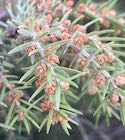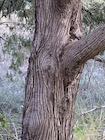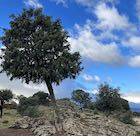Juniperus oxycedrus
Linnaeus 1753, p. 1038
Common names
Crvena kleka [Serbian]; prickly juniper [English]; genévrier cade, cedre piquant [French]; zeder wacholder [German]; ginepro pungente, ginepro rosso [Italian].
Taxonomic notes
Juniperus oxycedrus was formerly very broadly interpreted, but molecular and essential oil analyses have enabled segregation of J. brevifolia, endemic to the Azores; J. cedrus, endemic to the Canaries; J. navicularis, endemic to coastal Portugal; J. deltoides, widely distributed from Italy to Iran; and J. macrocarpa, a coastal species found from Spain to Cyprus. These taxa have been assigned to two clades in Section Juniperus, one with J. cedrus, J. macrocarpa, and J. oxycedrus; and the other with J. brevifolia, J. deltoides, and J. navicularis (Adams 2014, Boratynski et al. 2014, Farhat et al. 2019, Mao et al. 2010). Moreover, J. oxycedrus var. badia, which some authors recognize as a taxon of North Africa, has been shown to be only very slightly different on both morphological and molecular grounds, such that plants cannot be reliably distinguished in the absence of provenance data (Adams 2014). This leaves J. oxycedrus, native to western Europe and North Africa, as a single taxon with no infraspecific taxa, synonymous with J. oxycedrus var. oxycedrus as defined by other authors, e.g. Farjon (2005, 2010).
Description
Evergreen shrubs, or trees to 6 m tall and 30 cm diameter, with an erect, often multistemmed, rounded crown of spreading and ascending branches. Bark light gray, smooth. Twigs green, turning yellowish brown in later years, short, 3-angled. Leaves needle-like, linear with a long spiny apex, 15-20 mm long, prominently keeled, bearing 2 white adaxal stomatal bands. Pollen shed in spring. Seed cones axillary, solitary, brownish-red to reddish-purple and glaucous at maturity, globose, 6-12 mm diameter, usually bearing 2-3 broad-ovate, slightly trigonous seeds (Adams 2014).
Distribution and Ecology
Algeria, France (incl. Corsica), Italy (incl. Sardinia and extreme NW Italy), Morocco, Portugal, Spain (incl. Balearic Is.), Tunisia. On dry slopes and stony soils at 0-1000 m elevation, in woodland or more open settings (Adams 2014).
Remarkable Specimens
No data as of 2023.03.03.
Ethnobotany
The tough, reddish wood is used (rather like Juniperus virginiana) for construction, rough carpentry, and pencil-making. Cade oil, an essential oil, is extracted via dry distillation of the wood, and is used medicinally, particularly for dermatitis (Adams 2014).
Observations
See the collection records on iNaturalist, but note that many records from Italy eastwards have likely been misidentified as J. oxycedrus.
Remarks
The epithet is compounded from the Greek for "sharp", referring to the needles, and the Latin cedrus, a catchall term for conifers.
Arceuthobium oxycedri (Loranthaceae) is a (semiparasitic) mistletoe found only on this juniper species.
Citations
Adams, R.P. 2014. Junipers of the World, 4th ed. Trafford, Bloomington, IN.
Boratyński, A., Wachowiak, W., Dering, M., Boratyńska, K., Sękiewicz, K., Sobierajska, K., Jasińska, A.K., Klimko, M., Montserrat, J.M., Romo, A., Ok, T., and Didukh, Y. 2014. The biogeography and genetic relationships of Juniperus oxycedrus and related taxa from the Mediterranean and Macaronesian regions. Bot J Linn Soc 174(4):637–653. doi:10.1111/boj.12147.
Farhat, P., Hidalgo, O., Robert, T., Siljak-Yakovlev, S., Leitch, I.J., Adams, R.P., and Bou Dagher-Kharrat, M. 2019. Polyploidy in the conifer genus Juniperus: an unexpectedly high rate. Front. Plant Sci. 10: 676. doi:10.3389/fpls.2019.00676.
See also
Elwes and Henry 1906-1913 at the Biodiversity Heritage Library. This series of volumes, privately printed, provides some of the most engaging descriptions of conifers ever published. Although they only treat species cultivated in the U.K. and Ireland, and the taxonomy is a bit dated, still these accounts are thorough, treating such topics as species description, range, varieties, exceptionally old or tall specimens, remarkable trees, and cultivation. Despite being over a century old, they are generally accurate, and are illustrated with some remarkable photographs and lithographs.






